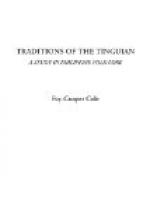[37] Similar incidents are to be found among the Ilocano and Igorot; in Borneo; in Java and India. See Reyes, Folklore Filipino, p. 34, (Manila, 1889); Jenks, The Bontoc Igorot, p. 202, (Manila, 1905); Seidenadel, The Language of the Bontoc Igorot, p. 491, 541, ff, (Chicago, 1909); Evans, Journal Royal Anthro. Inst., Vol. XLIII, 1913, p. 462; Ling Roth, Natives of Sarawak and British North Borneo, Vol. I, p. 319; Tawney, Katha Sarit Sagara, Vol. II, p. 3, (Calcutta, 1880); Bezemer, Volksdichtung aus Indonesien, p. 49, (Haag, 1904).
[38] This peculiar expression while frequently used is not fully understood by the story tellers who in place of the word “whip” occasionally use “make.” In one text which describes the Sayang ceremony, I find the following sentence, which may help us to understand the foregoing: “We go to make perfume at the edge of the town, and the things which we take, which are our perfume, are the leaves of trees and some others; it is the perfume for the people, which we give to them, which we go to break off the trees at the edge of the town.” Again in tale 20, Kanag breaks the perfume of Baliwan off a tree.—The use of sweetly scented oil, in raising the dead, is found in Dayak legends. See Ling Roth, The Natives of Sarawak and British North Borneo, Vol. I, p. 314.
[39] According to a Jakun legend, the first children were produced out of the calves of their mothers’ legs. Skeat and Blagden, Pagan Races of the Malay Peninsula, Vol. II, p. 185.—A creation tale from Mangaia relates that the boy Rongo came from a boil on his mother’s arm when it was pressed. Gill, Myths and Songs of the South Pacific, p. 10 (London, 1876).
[40] This power of transforming themselves into animals and the like is a common possession among the heroes of Dayak and Malay tales. See Ling Roth, The Natives of Sarawak and British North Borneo, Vol. I, p. 312; Perham, Journal Straits Branch R., Asiatic Society, No. 16, 1886; Wilkinson, Malay Beliefs, pp. 32, 59 (London, 1906).
[41] The present day Tinguian attach much importance to these omens. The gall and liver of the slaughtered animal are carefully examined. If the fluid in the gall sack is exceedingly bitter, the inquirer is certain to be successful; if it is mild he had best defer his project. Certain lines and spots found on the liver foretell disaster, while a normal organ assures success. See also Hose and McDougall, Pagan Tribes of Borneo, Vol. II, p. 60 ff.
[42] See p. 24, note 1.
[43] The present capital of Ilocos Sur.
[44] See p. 10, note 1.
[45] Barrows, Census of the Philippine Islands, Vol. I, pp. 456 ff., 1903.
[46] Paul P. de La Gironiere, who visited the Tinguian in the early part of the nineteenth century, describes these ornaments as follows: “Their heads were ornamented with pearls, coral beads, and pieces of gold twisted among their hair; the upper parts of the hands were painted blue; wrists adorned with interwoven bracelets, spangled with glass beads; these bracelets reached the elbow and formed a kind of half-plaited sleeve.” La Gironiere, Twenty Years in the Philippines, pp. 108 ff.




